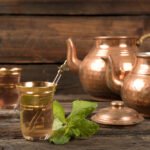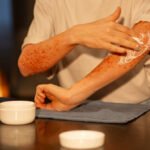Do your hands shake while performing daily tasks like writing or holding a cup? This uncontrollable trembling, known as Kampavata in Ayurveda, can affect confidence and quality of life. Modern medicine often manages tremors symptomatically, but Ayurveda addresses the root cause through balance of the Vata dosha, rejuvenation of the nervous system, and lifestyle correction.
In this blog, we’ll explore the Ayurvedic management of Kampavata, its causes, effective treatments, herbs, and practical home remedies to help you regain stability and control naturally.
What is Kampavata in Ayurveda?
In Ayurvedic literature, Kampavata is classified under Vata Vyadhi (neurological disorders). The term combines “Kampa” (tremor) and “Vata” (the bioenergy responsible for movement). When Vata dosha becomes aggravated due to aging, stress, irregular diet, or nervous exhaustion, it affects the motor and sensory functions, resulting in trembling, rigidity, and reduced coordination. This condition is considered analogous to Parkinson’s disease in modern medicine but is managed holistically in Ayurveda by targeting the root cause rather than merely controlling symptoms.
Causes and Symptoms of Kampavata
Common Causes (Nidana)
- Vitiation of Vata Dosha: The direct cause of tremors (Kampa) is the pathological increase of Vata, especially its moving quality (Chala Guna). When Vata becomes excessive or unstable, it produces involuntary movements and trembling. Common factors leading to Vata aggravation include:
- Mental stress, anxiety, or overexertion
- Irregular dietary habits and lifestyle patterns
- Sleep deprivation or erratic sleep cycles
- Natural aging, as Vata naturally predominates in later life
- Dhatu Kshaya (Tissue Degeneration): The progression of Kampavata is closely linked to Dhatu Kshaya, or depletion of vital tissues. Degeneration of Mamsa dhatu (muscle tissue) and Majja dhatu (nervous tissue) weakens structural and neurological integrity, resulting in muscle stiffness, rigidity, fatigue, and altered behavior.
- Avarana (Obstruction): In some cases, the normal flow of Vata becomes obstructed by other doshas, primarily Kapha. This condition, known as Avarana, hampers the functions of Vata. The obstruction disrupts nerve conduction, manifesting as slowness of movement (Chestasanga), poor coordination, and neurological imbalance.
- Depletion of Ojas (Vital Essence): Chronic Vata aggravation and tissue depletion eventually lead to a decline in Ojas, the body’s vital essence responsible for strength, immunity, and mental stability. Reduced Ojas weakens both physical and psychological resilience, aggravating symptoms such as tremors, instability, and fatigue.
Read more: Ayurvedic Treatment for Anxiety
Symptoms (Lakshana)
- Kampa (Tremors): It is characterized by involuntary shaking or trembling of body parts such as the hands, legs, head, or jaw. Tremors are often more noticeable at rest and may interfere with daily activities like writing or holding objects.
- Sthamba (Rigidity): Refers to stiffness or inflexibility of muscles, causing resistance to movement, muscle pain, and restricted range of motion.
- Chestasanga (Slowness of movement): Also known as bradykinesia, this symptom results in delayed initiation and slowness of voluntary movements, making routine actions like dressing or eating challenging.
- Avanamana (Flexed Posture): Individuals may develop a stooped or bent-forward posture due to muscle rigidity and imbalance in postural control.
- Dehabhramana (Postural Instability): Impaired balance and coordination can lead to unsteady walking, shuffling steps, and an increased tendency to fall.
- Vak Vikriti (Speech Disorders): Speech may become low-pitched, slurred, or monotonous, reflecting impaired coordination of vocal muscles.
- Micrographia: Due to hand tremors and poor fine motor control, handwriting often becomes small, cramped, and illegible.
- Loss of Automatic Movements: Reduced spontaneous gestures such as facial expressions (hypomimia), blinking, and natural arm swing while walking are common signs of neuromuscular sluggishness.
- Dysphagia (Difficulty Swallowing): In advanced cases, reduced muscle coordination in the throat may lead to difficulty swallowing or choking while eating.
- Nidrabhanga (Sleep Disturbances): Patients often experience insomnia, light sleep, or restlessness at night.
- Kshinamati and Smritihani (Cognitive and Memory Impairment): Progressive loss of concentration, mental alertness, and memory may occur in chronic stages, resembling dementia-like symptoms.
- Depression and Anxiety: Emotional disturbances such as sadness, irritability, or anxiety frequently accompany physical symptoms due to depletion of Ojas and nervous system stress.
Ayurvedic Approach to Managing Kampavata
Ayurveda treats Kampavata by restoring the balance of Vata dosha, rejuvenating the nervous system, and improving neuromuscular strength. Treatment includes detoxification, internal medications, and rejuvenation therapies.
Balancing Vata Dosha
The Ayurvedic management of Kampavata lies in balancing the Vata through nourishment and lubrication (Snehana). Practices include:
- Regular oil massage (Abhyanga) with medicated oils, including Mahanarayan taila, Balashwagandhadhi taila, Mahamasha taila, Dhanwantaram taila, and Ksheerabala taila.
- Gentle steam therapy (Swedana) to relieve stiffness.
- Shirodhara (pouring warm medicated oil over the forehead) for calming the nervous system.
Read more: Benefits of Drinking Water in a Copper Vessel
Panchakarma Treatments for Kampavata
Panchakarma plays a pivotal role in treating neurological disorders like Kampavata. At Back to Roots Ayurveda, individualized Ayurvedic treatments in Kerala are tailored to restore neurological balance. Effective Panchakarma therapies include:
- Swedana therapies, including Bashpa sweda, Nadi sweda, Pinda sweda, Churna pinda sweda, Patra pinda sweda, Shashtika sali pinda sweda, and Avagaha.
- Basti (Medicated Enema)
- Nasya (Nasal Therapy)
- Virechana (Medicated Purgation)
- Pizhichil
- Shiro Pichu
- Shiro Abhyanga
- Shiro Vasti
- Shiro Lepa
For deeper healing, consider an Ayurvedic retreat in Kerala that combines Panchakarma, meditation, and a therapeutic diet.
Ayurvedic Medicines for Tremors
Ayurvedic formulations for hand shivering treatment target both Vata pacification and nervous system rejuvenation. Commonly prescribed medicines include:
- Maharasnadi Kashaya
- Ashtavargam Kashaya
- Prasaraynadi Kashaya
- Drakshadi Kashaya
- Dasamoola Kashaya
- Balarishta
- Dasamoolarishta
- Ashwagandharishta
- Saraswatharishta
- Draksharishta
- Yogaraja Guggulu
- Trayodasanga Guggulu
- Brahmi Vati
- Panchatikta Ghrita Guggulu
- Ashwagandha Rasayanam
- Ajamamsa Rasayanam
- Dasamoola Hareetaki
Disclaimer: Always consume Ayurvedic medicines under the guidance of a registered Ayurvedic Medical Practitioner.
Home Remedies and Natural Solutions
In addition to Ayurvedic therapies, simple home-based remedies can help manage Kampavata effectively by supporting nervous system health and pacifying Vata dosha. Home remedies include:
- Massage using warm sesame or Dhanwantharam taila on affected areas daily.
- Drink milk boiled with Ashwagandha or Bala churna before bedtime.
- Practice gentle yoga and Pranayama to calm the nervous system.
- Ensure adequate rest and maintain emotional balance.
These remedies, along with consistent Ayurvedic care, offer long-term relief from tremors and shivering.
Read more: Ayurvedic Treatment for Insomnia
Diet and Lifestyle Recommendations
A balanced diet supports the reduction of symptoms and helps prevent further neurodegeneration.
Foods to Include:
- Warm, freshly prepared, and easily digestible meals
- Ghee (clarified butter) to nourish and strengthen the nerves
- Nuts and seeds rich in Omega-3 fatty acids, such as flaxseeds and walnuts
- Fresh fruits and vegetables, particularly spinach, carrots, and berries
- Herbal infusions like Brahmi tea and Ashwagandha tea
Foods to Avoid:
- Processed and packaged foods
- Excessive caffeine and alcohol
- Spicy, dry, or cold foods that aggravate Vata dosha
- High intake of salt and sugar
Lifestyle Modifications:
- Drink adequate amounts of water throughout the day to maintain hydration and support optimal body functions.
- Engage in light physical activities such as walking or gentle yoga (yogasanas) to enhance flexibility and strength.
- Regular movement helps preserve motor functions and improve overall coordination and balance.
- Practice meditation and deep breathing exercises to calm the mind and reduce stress and anxiety.
- Include mindfulness or self-awareness practices as part of holistic management to promote emotional stability.
- Maintain a consistent sleep and wake-up routine to regulate the body’s natural rhythm.
Ayurvedic Therapies at Back to Roots Ayurveda
At Back to Roots Ayurveda, Kampavata management focuses on personalized therapies that address the root cause of Vata imbalance. The expert physicians combine classical Panchakarma, therapeutic diet, and rejuvenating herbal medicines to ensure lasting recovery.
Kampavata is not merely a motor disorder; it reflects an underlying Vata imbalance that affects the body and mind. Through a combination of Panchakarma, herbal medicines, diet, and lifestyle practices, Ayurveda offers an effective, natural, and holistic approach to managing tremors. With expert care and consistent practice, patients can regain stability, confidence, and quality of life naturally. Book your consultation today and experience natural healing at Back to Roots Ayurveda.
FAQs
1. What is the main cause of Kampavata according to Ayurveda?
Kampavata primarily occurs due to the aggravation of Vata dosha, which governs movement and nerve functions. Factors such as stress, aging, irregular diet, sleep disturbances, and tissue degeneration (Dhatu Kshaya) contribute to this imbalance.
2. Which Panchakarma therapy is best for tremors?
Basti (medicated enema) is considered the most effective Panchakarma therapy for tremors, as it directly pacifies Vata dosha and nourishes the nervous system. Supportive treatments like Nasya and Shirodhara further enhance neurological balance.
3. Can Kampavata be completely cured through Ayurveda?
While complete reversal may depend on the severity and duration of the condition, Ayurvedic treatment can significantly reduce symptoms, slow progression, and improve quality of life through holistic management.
4. Which Ayurvedic herbs are effective for hand shivering?
Ashwagandha, Bala, Kapikacchu, Brahmi, and Mucuna pruriens are highly effective in strengthening nerves, calming tremors, and restoring neuromuscular coordination.
5. How long does Ayurvedic treatment take to show results?
Noticeable improvement is generally seen within 4 to 8 weeks of consistent therapy, diet, and lifestyle modification, though chronic cases may require longer treatment for sustained relief.







